It’s no secret that Trevor Bauer has historically been anti-foreign substance. He’s spoken out against them as recently as February of this year, and he caused quite the commotion when he rather brazenly accused the Houston Astros of using foreign substances to increase their players’ spin rates in a 2018 tweet. So it was somewhat surprising to see Bauer come out to start 2020 flashing elevated spin rates that suggest he was doctoring the ball.
I don’t think I need to provide any further evidence that Bauer starting using a pine tar equivalent. Several outlets have written about it — including our own Zach Hayes — and Bauer has all but admitted it himself. In 2018, he said that pine tar could add about 400 rpm to his fastball. Let’s take a peek at his spin rate over his career:
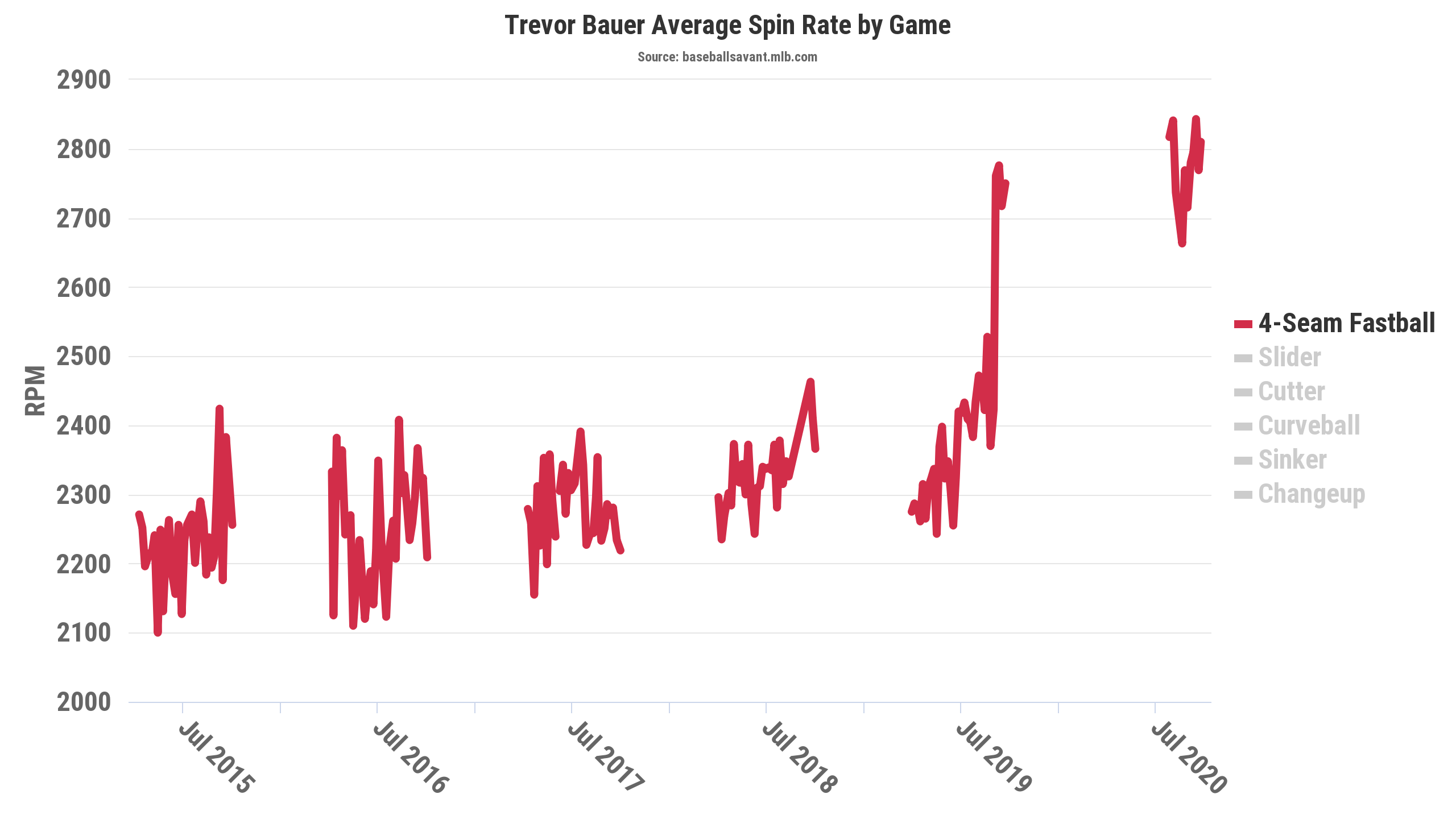
Compared to his season averages, Bauer bumped up his fastball’s spin rate by nearly 400 rpm. However, you can pretty plainly see that, beginning in September of 2019, Bauer’s spin rate starting spiking to its 2020 level of spin. If we filter those games out, then Bauer’s spin rate indeed increased by over 400 rpm. Bauer, apparently, no longer cares for having the moral high ground on other sticky-fingered pitchers.
With that aside, I can get into what I wanted to talk about — Bauer had really favorable outcomes in 2020! Here’s the linchpin behind it all:
https://gfycat.com/adeptwaterloggedaxisdeer
Fairly mundane! In fact, it’s perhaps the most ordinary-looking play in baseball. Boringness aside, this is one of the best possible outcomes for pitchers, aside from a strikeout. The expected batting average of pop-ups in 2020? .043. A pop-up is virtually a guaranteed out — this is nothing new. And Bauer? He’s induced a lot of pop-ups.
Here’s a list of pitchers, ranked by pop-up percentage:
| PU% | |
|---|---|
| Trevor Bauer | 15.8% |
| Cristian Javier | 14.8% |
| Josh Lindblom | 14.7% |
| Danny Duffy | 13.3% |
| Deivi Garcia | 13.2% |
Bauer ranks the highest in pop-up percentage in baseball. It’s a skill that he’s always had — he ranks in the 66th percentile in pop-up percentage from 2018 to 2019 — but this is quite the jump for him, given he had the most pop-ups in the league. So, the question becomes this: is this sustainable? Maybe! We’ll get there soon enough.
Given that his spin rate went up so drastically, it’s intuitive that it helped his fastball played up. Via Brooks Baseball, we can see how much! First, by short-form vertical fastball movement:
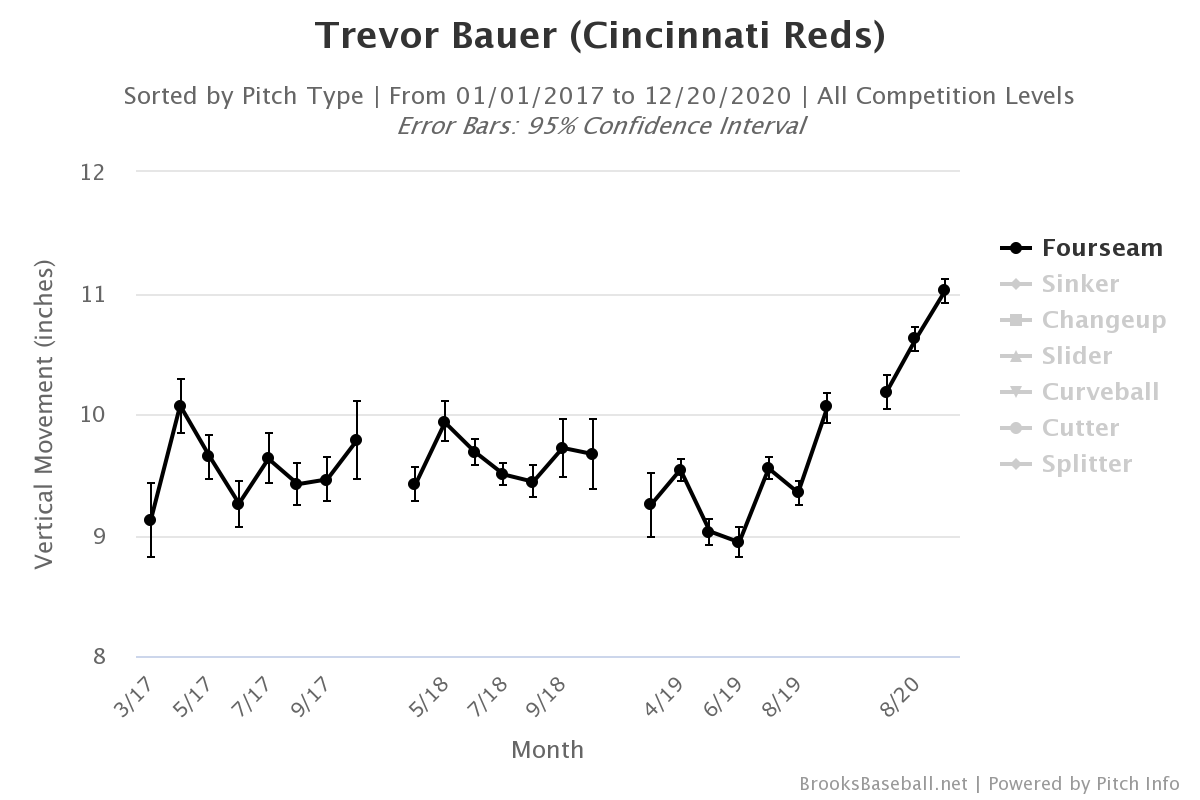
You can see a large increase in fastball ride. Not only has he gained more than an inch of ride compared to his past few years, but this is a career-high for him, and a level of ride he hasn’t even been in the vicinity of, aside from 2012 and 2014.
Again, we’ll look at his vertical fastball movement, but this time long-form:
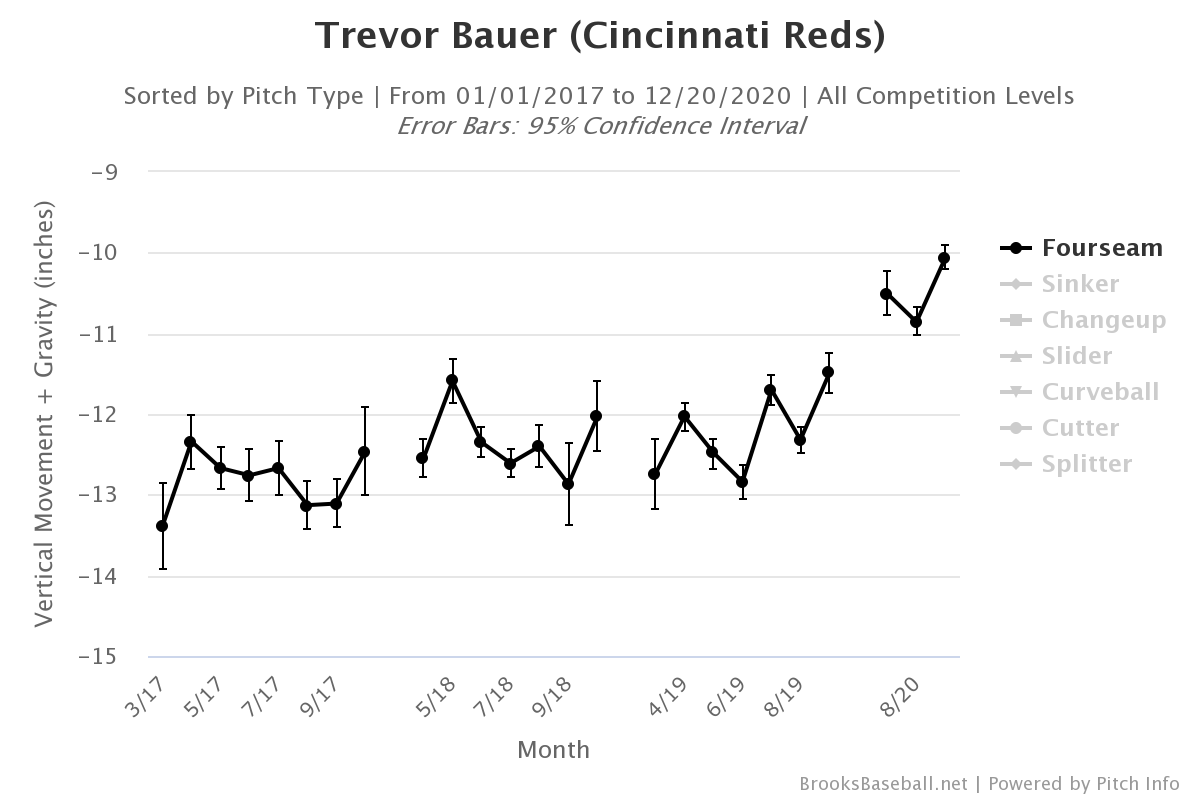
Different graphic, similar result. Bauer has reached unprecedented levels of fastball ride — at least for him. What that means is that, more than ever, his fastball (a) gives the illusion of rise to hitters, and (b) wherever hitters think Bauer’s fastballs will end up, the ball will end up being inches higher. That’s enough to turn a barrel or hard-hit fly ball into a lazy fly ball or, as is often the case for Bauer, a pop-up.
In many ways, Bauer hasn’t changed though. Consider his average vertical fastball location, by year:
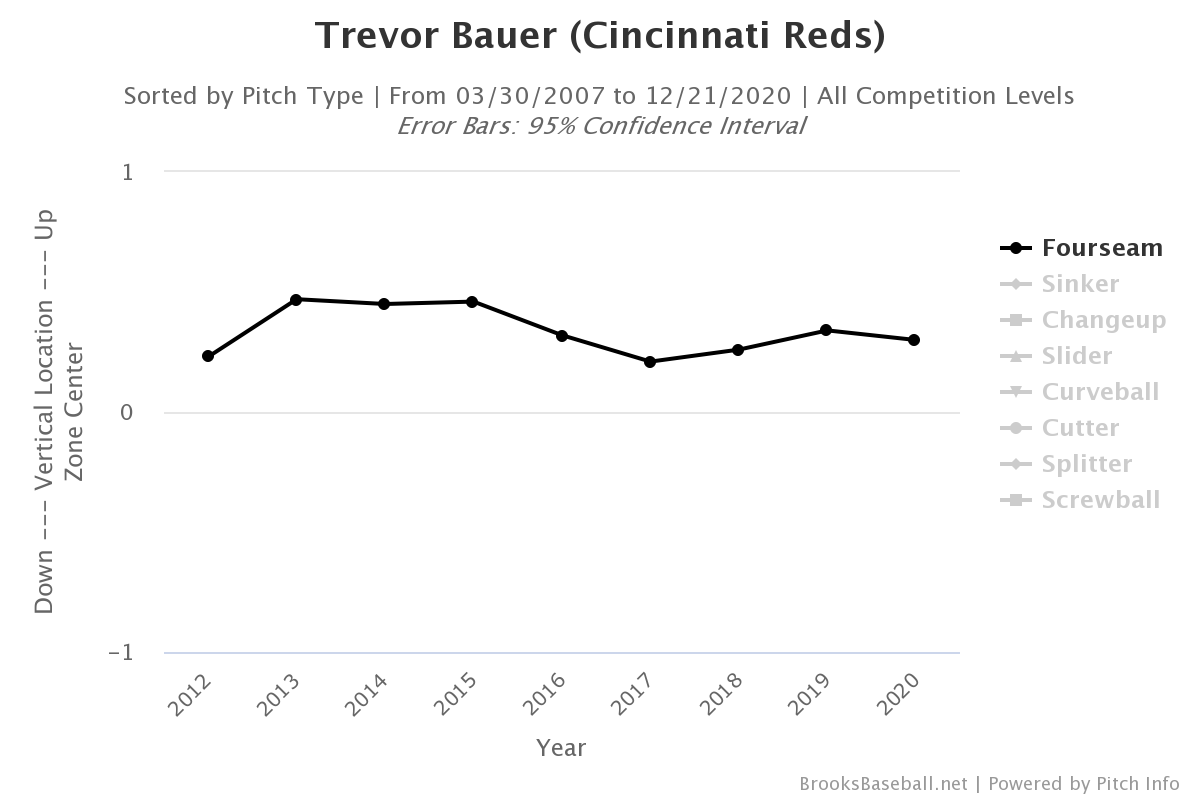
As well as his fastball location from 2018 to 2020, by pitch plot:
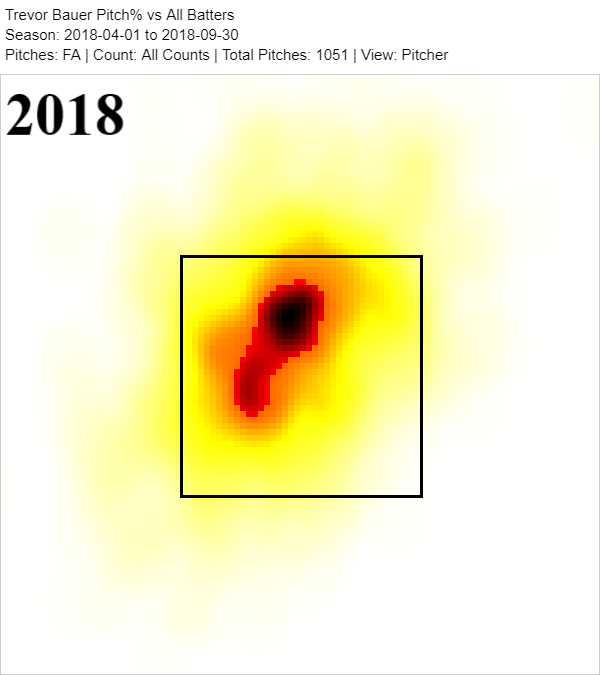
On the whole, Bauer hasn’t changed much in terms of fastball location. The difference is simple: he just has a much better fastball. Now, given that his Bauer Units (i.e., spin rate divided by velocity) increased so exponentially, it’s fair to think that this can’t sustain itself without his ostensible foreign substance use.
That’s one issue. Bauer might not have this fastball next year. If he loses any spin, he’ll lose pop-ups with it. The other issue is that fastball pop-up percentage isn’t very sticky.
I had Jeremy Siegel take the pop-up percentage of all starting pitchers’ fastballs with 50 batted ball events or more since 2015 and compare them to their pop-up percentages the next year. He found an R2 of .11, which means that 11% of the variation in a player’s fastball pop-up percentage can be explained by their pop-up rate from the previous year. For those unfamiliar, that’s not very robust! And so, despite Bauer having a much-improved fastball, I would bet the under on a 15% pop-up percentage on his fastball. Given that the R2 for overall pop-up percentage is about .20, I’d bet the under on his overall 15% pop-up percentage based on statistical variation alone.
Now, I’ll admit, as I’ve written this article, I’ve started to come around on how I feel about Bauer as a strike-thrower, which makes me think he can sustain his strikeout percentage more than I’d previously thought. Given my findings above, though, I remain skeptical of his ability to sustainably limit hitter-friendly contact.
Given that there is so much statistical variability, allow me to show you what I mean with the following table:
| xwOBA | xwOBAcon | K-BB% | SwStr% | |
|---|---|---|---|---|
| 2017 | .327 | .410 | 18.2% | 9.1% |
| 2018 | .266 | .340 | 22.9% | 13.3% |
| 2019 | .315 | .391 | 18.8% | 12.2% |
| 2020 | .219 | .300 | 29.9% | 12.8% |
In 2018, Bauer had what many consider a breakout season. While I think it was legitimately a step forward for him (i.e., an increase in SwStr%), he had just a 0.46 HR/9, and his .340 xwOBAcon was deflated due to his slider and changeup having unsustainably low BABIPs and wOBAcons. Never bet on these numbers to be repeated!
This year, it’s gotten harder to deny the sustainability of the package that Bauer presents. When he has this fastball, he’s legitimately good. I’m not sure how many people would deny that. With a .215 BABIP and 90.9% LOB%, we know that his 1.73 ERA isn’t going to persist. The question is how much he’s set to regress (or revert!).
In borrowing from Alex Chamberlain’s approach, I’ll compare Bauer’s xwOBAcon numbers to league averages at the pitch level:
| 2018 | 2020 | |||
|---|---|---|---|---|
| Pitch Type | Bauer | League | Bauer | League |
| Four-seamer | .320 | .385 | .320 | .402 |
| Cutter | .243 | .361 | .243 | .372 |
| Slider | .241 | .356 | .301 | .357 |
| Curveball | .449 | .371 | .449 | .379 |
In 2018, Bauer’s changeup, slider, and fastball overperformed drastically by wOBAcon. By xwOBAcon, his fastball, cutter, and slider overperformed significantly as well. In 2019, Bauer’s fastball, changeup, and slider came back to earth rather ungracefully — uglily, you could say — and he had a league-average year by xwOBA and ERA despite a solid K-BB%.
His 2020 signals something similar! His overall .300 xwOBAcon ranks in the 99th percentile in MLB, but given the volatility of batted balls, that could change quickly moving into 2021. The pendulum has swung back and forth since 2018 — a strong 2018, poor 2019, and strong 2020. Perhaps it will swing back in 2021, and his pitches will get hit around, once again.
Bauer’s career average xwOBAcon is .375, while league average is .376. Given these two numbers alone, I would think that his 2021 regresses more towards those, as opposed to his .340 from 2018 or .300 from 2020. Based on statistical noise alone, it’s reasonable enough that this could happen.
Bauer has weaponized a fastball that is more than likely playing up due to sticky stuff. Thus far, he has yet to show us that he’s an elite pitcher without (a) batted ball luck, or (b) foreign substances. It’s been nearly three years since his so-called breakout, and yet we’re still ambivalent as it pertains to Bauer’s true talent level. It looks like Bauer will use a foreign substance moving forward as much of the league does, and so perhaps we will see more of the 2020 version of him more than the 2019 version moving forward.
Photo by Mark Goldman/Icon Sportswire, Graphic created by Justin Paradis (@freshmeatcomm on Twitter)

